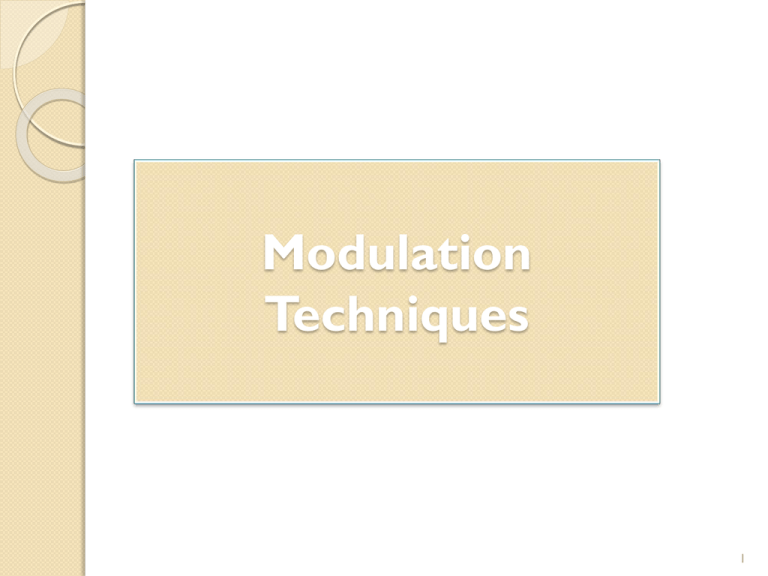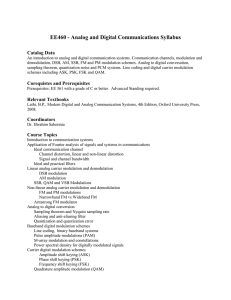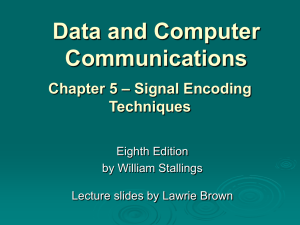File
advertisement

Modulation Techniques 1 Introduction A digital signal is superior to an analog signal because it is more robust to noise and can easily be recovered, corrected and amplified. For this reason, the tendency today is to change an analog signal to digital data. In this section we describe two techniques, pulse code modulation and delta modulation… 2 Topics discussed in this section: Pulse Code Modulation (PCM) Delta Modulation (DM) 3 Pcm 4 INTRODUCTION TO PCM PCM consists of three steps to digitize an analog signal: 1. 2. 3. Sampling Quantization Binary encoding Before we sample, we have to filter the signal to limit the maximum frequency of the signal as it affects the sampling rate. Filtering should ensure that we do not distort the signal, ie remove high frequency components that affect the signal shape. 5 Pulse code modulation (PCM) is a procedure of converting an analog into a digital signal in which an analog signal is sampled and then the difference between the actual sample value and its predicted value (predicted value is based on previous sample or samples) is quantized and then encoded forming a digital value… 6 Concept of PCM encoder 7 Sampling Analog signal is sampled every TS secs. Ts is referred to as the sampling interval. fs = 1/Ts is called the sampling rate or sampling frequency. There are 3 sampling methods: ◦ Ideal - an impulse at each sampling instant ◦ Natural - a pulse of short width with varying amplitude ◦ Flattop - sample and hold, like natural but with single amplitude value The process is referred to as pulse amplitude modulation PAM and the outcome is a signal with analog (non integer) values 8 Types of Sampling 9 Recovery of a sampled sine wave for different sampling rates 10 Quantization Sampling results in a series of pulses of varying amplitude values ranging between two limits: a min and a max. The amplitude values are infinite between the two limits. We need to map the infinite amplitude values onto a finite set of known values. This is achieved by dividing the distance between min and max into L zones, each of height = (max - min)/L 11 PCM Decoder To recover an analog signal from a digitized signal we follow the following steps: We use a hold circuit that holds the amplitude value of a pulse till the next pulse arrives. We pass this signal through a low pass filter with a cutoff frequency that is equal to the highest frequency in the presampled signal. The higher the value of L, the less distorted a signal is recovered. 12 Components of a PCM decoder 13 Bit rate and bandwidth requirements of PCM The bit rate of a PCM signal can be calculated form the number of bits per sample x the sampling rate Bit rate = nb x fs The bandwidth required to transmit this signal depends on the type of line encoding used. Refer to previous section for discussion and formulas. A digitized signal will always need more bandwidth than the original analog signal. Price we pay for robustness and other features of digital transmission. 14 Moulation Of Pcm In the diagram, a sine wave (red curve) is sampled and quantized for pulse code modulation.The sine wave is sampled at regular intervals, shown as ticks on the x-axis. For each sample, one of the available values (ticks on the y-axis) is chosen by some algorithm. This produces a fully discrete representation of the input signal (shaded area) that can be easily encoded as digital data for storage or manipulation. For the sine wave example at right, we can verify that the quantized values at the sampling moments are 7, 9, 11, 12, 13, 14, 14, 15, 15, 15, 14, etc. Encoding these values as binary numbers would result in the following set of nibbles: 0111 (23×0+22×1+21×1+20×1=0+4+2+1=7), 1001, 1011, 1100, 1101, 1110, 1110, 1111, 1111, 1111, 1110, etc. These digital values could then be further processed or analyzed by a digital signal processor. Several PCM streams could also be multiplexed into a larger aggregate data stream, generally for transmission of multiple streams over a single physical link. One technique is called time-division multiplexing (TDM) and is widely used, notably in the modern public telephone system. The PCM process is commonly implemented on a single integrated circuit and is generally referred to as an analog-to-digital converter (ADC). Demodulation To produce output from the sampled data, the procedure of modulation is applied in reverse. After each sampling period has passed, the next value is read and the output signal is shifted to the new value. As a result of these transitions, the signal will have a significant amount of high-frequency energy. To smooth out the signal and remove these undesirable aliasing frequencies, the signal is passed through analog filters that suppress energy outside the expected frequency range (that is, greater than the Nyquist frequency ).[note 1] The sampling theorem suggests that practical PCM devices, provided a sampling frequency that is sufficiently greater than that of the input signal, can operate without introducing significant distortions within their designed frequency bands. The electronics involved in producing an accurate analog signal from the discrete data are similar to those used for generating the digital signal. These devices are Digital-to-analog converters (DACs), and operate similarly to ADCs. They produce on their output a voltage or current (depending on type) that represents the value presented on their digital inputs. This output would then generally be filtered and amplified for use. 16 Limitation There are potential sources of impairment implicit in any PCM system: Choosing a discrete value near the analog signal for each sample leads to quantization error.[note 2] Between samples no measurement of the signal is made; the sampling theorem guarantees non-ambiguous representation and recovery of the signal only if it has no energy at frequency fs/2 or higher (one half the sampling frequency, known as theNyquist frequency); higher frequencies will generally not be correctly represented or recovered. As samples are dependent on time, an accurate clock is required for accurate reproduction. If either the encoding or decoding clock is not stable, its frequency drift will directly affect the output quality of the device 17 Delta Modulation 18 Introduction This scheme sends only the difference between pulses, if the pulse at time tn+1 is higher in amplitude value than the pulse at time tn, then a single bit, say a “1”, is used to indicate the positive value. If the pulse is lower in value, resulting in a negative value, a “0” is used. This scheme works well for small changes in signal values between samples. If changes in amplitude are large, this will result in large errors. 19 Process of delta modulation 20 Delta modulation component 21 Block diagram of DM 22 Delta demodulation component 23 Next form of pulse modulation the delta modulation Transmits information only to indicate whether the analog signal that is being encoded goes up or goes down The Encoder Outputs are highs or lows that “instruct” whether to go up or down, respectively DM takes advantage of the fact that voice signals do not change abruptly The analog signal is quantized by a one-bit ADC (a comparator implemented as a comparator) The comparator output is converted back to an analog signal with a 1-bit DAC, and subtracted from the input after passing through an integrator The shape of the analog signal is transmitted as follows: a "1" indicates that a positive excursion has occurred since the last sample, and a "0" indicates that a negative excursion has occurred since the last sample. 24 Waveform 25 Signal Encoding Digital to Digital ◦ unipolar, polar, bipolar. Analog to Analog ◦ Amplitude Modulation, Frequency Modulation, Phase Modulation Analog to Digital ◦ Pulse Code Modulation Digital to Analog ◦ ASK, FSK, PSK, QAM Basic Encoding Techniques Digital data to analog signal ◦ Amplitude-shift keying (ASK) Amplitude difference of carrier frequency ◦ Frequency-shift keying (FSK) Frequency difference near carrier frequency ◦ Phase-shift keying (PSK) Phase of carrier signal shifted ◦ Quadrature Amplitude Modulation (QAM). Hierarchy Types of digital-to-analog modulation Amplitude-Shift Keying One binary digit represented by presence of carrier, at constant amplitude Other binary digit represented by absence of carrier A cos2f ct s t where the carrier signal is0Acos(2πfct) binary 1 binary 0 Digital to Analog Modulation • Amplitude Shift Keying (ASK) – the strength of the carrier signal is varied to represent binary 0 or 1 – Both frequency and phase remain constant while amplitude changes – The peak amplitude of the signal during each bit duration is constant – ASK transmission is highly susceptible to noise interference Amplitude Shift Keying (ASK) (contd.) Bandwidth for ASK BW 1 d Nbaud ◦ Nbaud: the baud rate ◦ d: the factor related to the modulation process (with a minimum value of 0) Amplitude-Shift Keying Susceptible to sudden gain changes Inefficient modulation technique On voice-grade lines, used up to 1200 bps Used to transmit digital data over optical fiber Amplitude Shift Keying (ASK) (contd.) A popular ASK technique is called on/off keying (OOK) ◦ One of the bit value is represented by no voltage ◦ () reducing total required transmission energy Binary Frequency-Shift Keying (BFSK) Two binary digits represented by two different frequencies near the carrier frequency A cos2f1t s t A cos2f 2t binary 1 binary 0 where f1 and f2 are offset from carrier frequency fc by equal but opposite amounts Frequency Shift Keying (FSK) The frequency of the carrier signal is varied to represent binary 1 or 0 Both peak amplitude and phase remain constant Frequency Shift Keying (FSK) (contd.) () avoiding most of the problems from noise () the limiting factors are the physical capabilities of the carrier Bandwidth for FSK BW=fc1 fc0+ Nbaud Binary Frequency-Shift Keying (BFSK) Less susceptible to error than ASK On voice-grade lines, used up to 1200bps Used for high-frequency (3 to 30 MHz) radio transmission Can be used at higher frequencies on LANs that use coaxial cable Phase-Shift Keying (PSK) Two-level PSK (BPSK) ◦ Uses two phases to represent binary digits binary 1 A cos2f ct s t binary 0 A cos2f ct A cos2f ct A cos2f ct binary 1 binary 0 Phase Shift Keying (PSK) The phase of the carrier is varied to represent binary 1 or 0 Both amplitude and frequency remain constant Also called 2-PSK or binary PSK (only o0 and 1800) Phase Shift Keying (PSK) (contd.) Constellation () not susceptible to the noise degradation that affects ASK () not susceptible to the bandwidth limitation that affects FSK Phase Shift Keying (PSK) (contd.) Bandwidth for PSK ◦ The minimum bandwidth required for PSK transmission is the same as that required for ASK transmission ◦ PSK and ASK have the same baud rate ◦ PSK has higher bit rate than ASK Phase-Shift Keying (PSK) Four-level PSK (QPSK) ◦ Each element represents more than one bit st A cos 2f c t 4 3 A cos 2f c t 4 3 A cos 2f c t 4 A cos 2f c t 4 11 01 00 10 4-PSK Also known as Q-PSK Dibit: the pair of bits represented by each phase Twice transmission rate, compared to 2-PSK Digital to Analog Modulation • Phase Shift Keying (PSK) The following figure shows clearly the relationship of phase to bit value 2-PSK constellation 4-PSK constellation 8-PSK constellation Quadrature Amplitude Modulation (QAM) Why QAM? ◦ PSK is limited by the capability of the equipment to distinguish small differences in phase ◦ Thus limit its potential bit rate QAM is a combination of ASK and PSK In general, the number of amplitude shifts is fewer than the number of phase shifts Quadrature Amplitude Modulation (QAM) (contd.) Figure 5.15 Time domain for an 8-QAM signal Quadrature Amplitude Modulation (QAM) (contd.) Figure 5.14 The 4-QAM and 8-QAM constellations Quadrature Amplitude Modulation QAM is a combination of ASK and PSK ◦ Two different signals sent simultaneously on the same carrier frequency st d1 t cos 2f ct d 2 t sin 2f ct Simple implementation of DM 50 Limitation of Dm Slope overload When the analog signal has a high rate of change, the DM can “fall behind” and a distorted output occurs 51 Thank you 52



